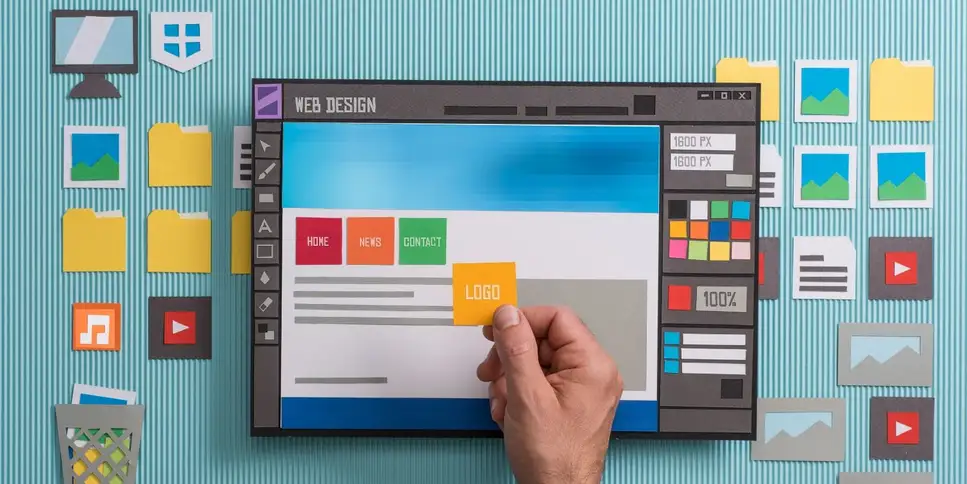Chat with Ava - Your AI Business Consultant
Hi I'm Ava, your AI guide to supercharging your business!
Whether you're already running a business or dreaming of starting one, I'm here to help turn your vision into reality using AI powered freelancers. Share your business goals, and together, we'll create a project that our talented freelancers can bid on. Let's make your vision a reality!
I have a business
I'm starting a business
Something went wrong while sending the conversation to your email. Please try again later.
You can only save your conversation once per hour. Please try again later.
Your conversation is too short. Keep chatting with Ava to enable saving.
How to get a high-fidelity mockup of your website created
Getting a high-fidelity website mockup created is a vital part of building your site. We'll show you how to get it done on a budget.
Mar 19, 2020 • 7 minute read
Updated on Aug 4, 2020 by Gauri G.

Writer and Data Entry Professional
Copy to clipboard failed, please try again after adjusting your permissions.
Copied to clipboard.

A high-fidelity mockup shows you exactly how your finished website will look to visitors
If you've already gotten your website wireframed, gotten some content produced for it and have a good idea of the site's user interface and user experience, it's time to get a pixel-perfect mockup done by a web designer.
Mockups or prototypes are created in the initial stages of a website design and development project. They give you a detailed and realistic picture by demonstrating color schemes, icons, fonts, images, navigation visuals, and the layout of content. In other words, it is crucial to design a mockup to know the overall appearance of your web design, including functionality and architecture.
The high-fidelity mockup is a none-coded representation of how your site will actually look and function. It's created by a graphic designer, who hands the mockup off to a web developer for final coding.
Experts consider high fidelity mockups as the best tools for maintaining cost-effectiveness of website development projects. If you want to avoid making multiple revisions at the development stage, then you need to start with a robust high-fidelity mockup design that has undergone multiple iterations without the need for coding.
The question you may ask is whether you really need a high-fidelity mockup design or is a sketch sufficient enough? And, if you do, then what's the best way to get one designed for your website? How much will it cost? So, read on to find the answers to all these questions.
Benefits of using high fidelity mockups
Getting high fidelity mockups built in the initial stages of your website development project can add an extra dose of efficiency to the entire process. Apart from this, you can also benefit in the following ways,
Detect errors early on
To begin with, putting together a website mockup tells you whether the proposed website design is aesthetically pleasing or not. Secondly, you can see where the design lacks functionally. This gives you an excellent opportunity to detect errors and improve the design at an early stage. Therefore, a high-fidelity mockup is necessary to identify which visual components stand out like sore thumbs and which fit right in with the intended visual hierarchy and design.
Improve communication
You can use high fidelity mockups to improve collaboration with the web developer working on the project. Having a clear understanding in the mockup stage allows for a smooth handover to the development team. A final website mockup including a well-defined design system and documentation will ensure that the final product is created as per your expectations.
Generate valuable feedback
High fidelity mockups designs help you get valuable feedback from stakeholders and the target customer segment before your design goes in the production phase. You can use the inputs to re-define your mockup or its functionality before it is handed over to the development team.
Cost/time efficiency
This may sound counterintuitive, as a high fidelity mockup still needs to be coded in HTML, CSS and JavaScript, but creating a pixel-perfect mockup before coding means fewer revisions for your website. You'll end up saving development time by giving your developer a framework that's as close to the final UI/UX as possible.
Looking at this, it seems only logical that you should create high fidelity mockups before starting the actual website coding.
How much does a high fidelity website mockup cost?
Most agencies charge significant fees for creating high fidelity mockups as they require higher levels of skills than say, sketches or low fidelity mockups. However, agencies are not the only type of vendors who can help you here. You can hire a freelancer to create a high-fidelity mockup at a fraction of the cost and in much less time. Plus, you are dealing directly with the designer, which is essential at this stage where ideas are taking shape and there can be no gap in communication.
Assigning high fidelity mockup projects to freelancers not only allows you to pay less, but it also reduces the hassle involved without compromising on the end product. Plus, you'll be communicating directly with the web designer creating your mockup, rather than through an agency account manager.
How does a freelancer produce a high-fidelity mockup?
Website wireframes are basic and low fidelity blueprints that give you a high-level idea of the general layout of your proposed website. High fidelity mockup designs, on the other hand, function as a static wireframe complete with visual design. They convey important visual components representing color and contrast for a more informed decision-making.
A freelance designer can create a high-fidelity mockup design by studying and analyzing the functionality of the prospective website. This is done by assessing the following elements in the mockup phase for presenting a design offering optimum functionality.
Content layout
As the name suggests, this defines how the content gets displayed on your website across different pages and sections. In the mockup development phase, both images and text are considered as content. Therefore, most freelancers will use the Gutenberg diagram (Z pattern ) to optimize the ‘reading gravity’ in user behavior. This is the right place to define how much content you want to include on your site.
Typography
Typography is an excellent tool for redirecting the focus of your target user. It improves the overall understanding of the layout and determines the hierarchy of texts and other relevant elements in your website design.
The size, type, and style of the font including text alignment and spacing all come under typography. It is important to ensure that these visual design elements maintain the aesthetic appeal of the website.
Color schemes
Different website designs will look good in different colors and shades. It is very important to get this right from the beginning as color schemes that you choose can have a significant impact on your visitors and users. For instance, your choice of background color should work towards attracting the user towards the content reflected on it. In other words, it needs to add to the appeal of your website making it more visible and attractive.
Negative space
Negative space aka white space is basically an empty area that is left to balance the website. A freelance designer includes it to avoid overloading your site’s web pages or leaving too many empty spaces. It is important to strike the perfect balance.
Visual navigation tools
Sliders, footers, pull-down menus, or toggles are all examples of user navigation visual tools that are essential for designing a picture-perfect website. Including these clearly in a high-fidelity mockup allows you to visualize how the final website will be navigated.
High fidelity mockup development
Since the actual development of your website is dependent on the accuracy of the mockup, it needs to be an accurate representation of your website, matching it pixel to pixel. A freelance web designer will employ the following steps to ensure this,
Approach
Different web designers can employ different approaches. For instance, some might want to lead the mockup development with a ‘mobile-first’ approach while others might begin with a focus on the desktop version. This is where, as the owner of the business, your experience with customers can suggest the best approach. It is important to be on the same page before initiating the task.
Considerations
Apart from which approach to take, the web developer is dependent on you for providing clear instructions. This includes considerations that can help align the final mockup with your expectations. Therefore, in order to arrive at an accurate mockup development estimate, the developer will require a clear idea on components like screen size, number of screens, functionality requirements, style guides, etc.
Development timeline
Mockup development timelines vary according to each project. So, after defining the requirements, both parties can arrive at a mutually agreeable delivery timeline that fits with your final website development phase.
Popular tools
Once the project is awarded a freelancer may use the following mockup design tools to create a high-fidelity mockup:
User testing and revisions
You can start user testing once the basic interactions, layout, and visual designs are set in place. Usability testing can be performed under the following 3 categories,
Explorative
To assess the usability and effectiveness of the high-fidelity mockup including the users’ conceptual understanding.
Assessment
Real-time evaluation of technology to assess overall usability and satisfaction.
Comparative
A comparative analysis of at least two instructional technology designs to assess their strengths and weaknesses.
A high-fidelity mockup can also be a clickable mock website version that your users can explore to give their initial feedback. You can use these inputs and make revisions before conducting another user testing. It will cost you much less to fix any issues at this stage than when the project goes into the development phase.
Important details to keep in mind
It is crucial that your users understand that this is a mockup and not the final product.
Make sure you have the right test set of users.
The mockup should include more than one potential user flow.
Provide clear testing instructions.
The perfect handover
The success of a perfect website mockup is also dependent on how comprehensively the designer hands it over to the development team. While it may sound like a simple sign off, it is a much more intricate process. The freelancer needs to ensure that all relevant documentation is handed over without any gaps. This information includes,
Final words
A responsive high-fidelity mockup design for your website can actually help you save money as you end up with the right website from day one itself. You can cut down the expenditure on fixing potential problems that may arise in the development phase by focusing on responsiveness early on and correcting any design flaws. So, write a detailed brief and post your project to find the perfect freelancer for your high-fidelity mockup design.
Tell us what you need done
Enter your project name
Related Stories
Talk to one of our Technical Co-Pilots to help with your project
Recommended Articles Just for You

The process of creating a website is very daunting if you have no experience. In this process we break down the complexity into 15 actionable steps.
13 min read

A specifications document, or spec, helps you determine who to get to build your website, how to build it and how much it will cost.
9 min read

Wireframe creation is critical to website design, but it doesn't need to be complicated. We will teach the stress-free process.
5 min read

Hiring freelancers for a project can save you time and money, but it's important to understand how to get the best results
4 min read
Thanks! We’ve emailed you a link to claim your free credit.
Something went wrong while sending your email. Please try again.
Loading preview
Permission granted for Geolocation.
Your login session has expired and you have been logged out. Please log in again.




